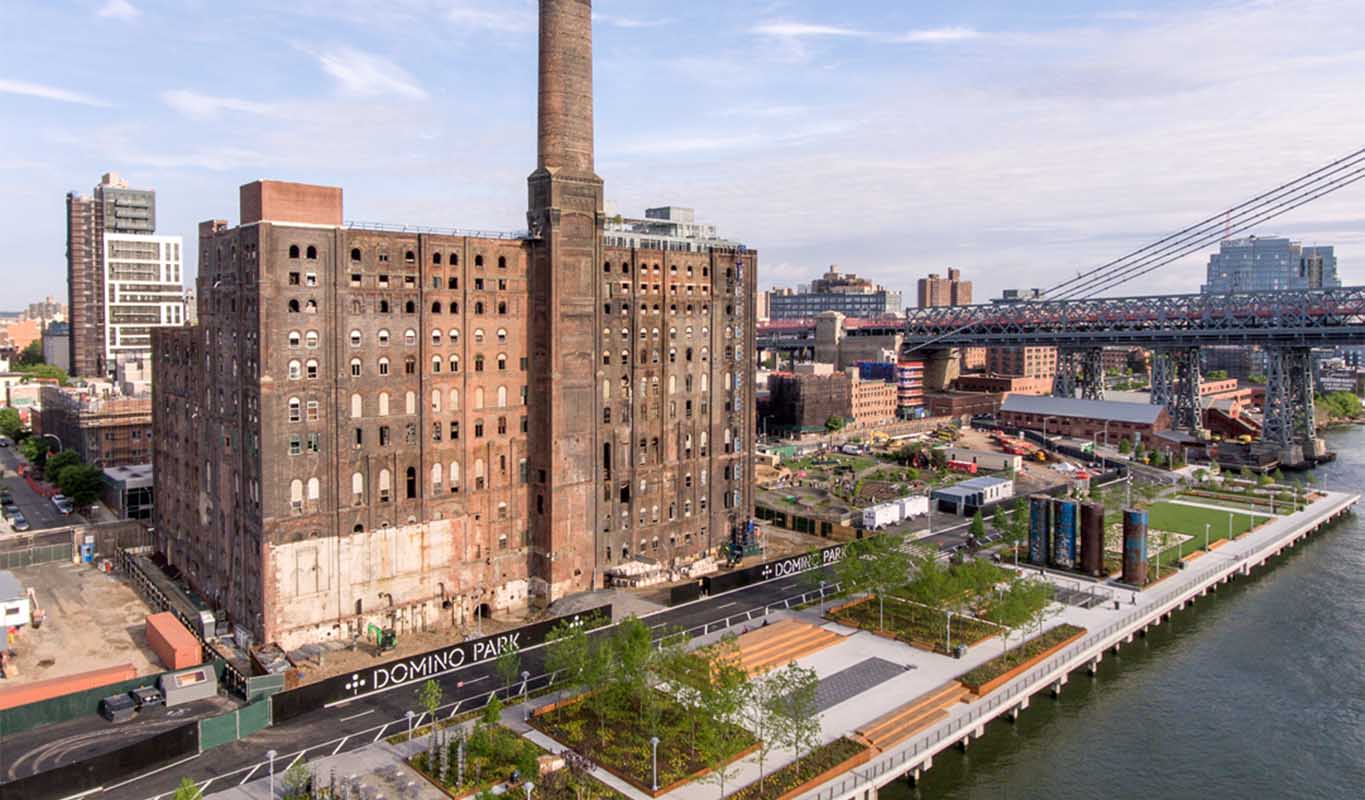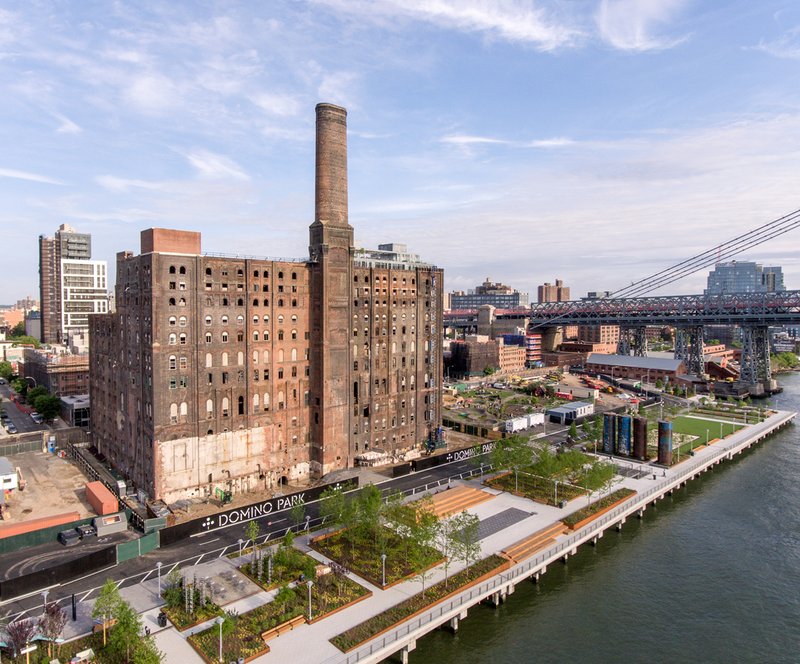 New Domino Park with Domino Refinery in behind. Photo by Daniel Levin, courtesy Domino Park.
New Domino Park with Domino Refinery in behind. Photo by Daniel Levin, courtesy Domino Park.
On Sunday, June 10th, Domino Park will finally debut to the public, bringing a brilliant dash of color to the historic industrial site along the Williamsburg waterfront. Just two months ago in April, we had the opportunity to tour the massive, six-acre park while it was still under construction. Now with the park’s scheduled opening around the corner, we headed back to the site for a first look at the completed green space on a tour led by representatives from Brooklyn-based developer, Two Trees Management, and designers from landscape architecture firm, James Corner Field Operations (the lead designers of the High Line).
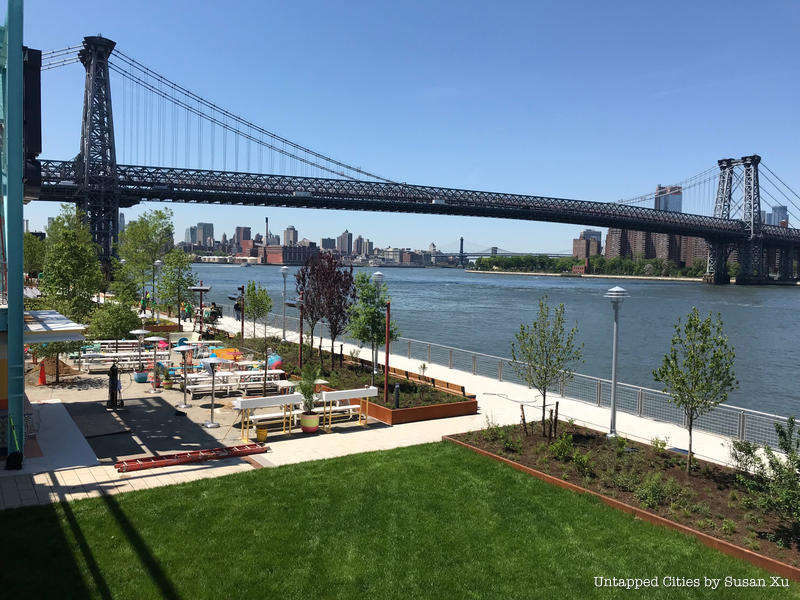
Privately funded by Two Trees, Domino Park is part of a mega-development project that includes five buildings, such as the already built residential edifice on 325 Kent Avenue. With a total footprint that stretches a quarter of a mile — beginning across the inlet from Grand Ferry Park and ending at South 5th Street — the highly anticipated green space not only provides visitors with improved access to the Williamsburg waterfront, but also reconnects the street grid.
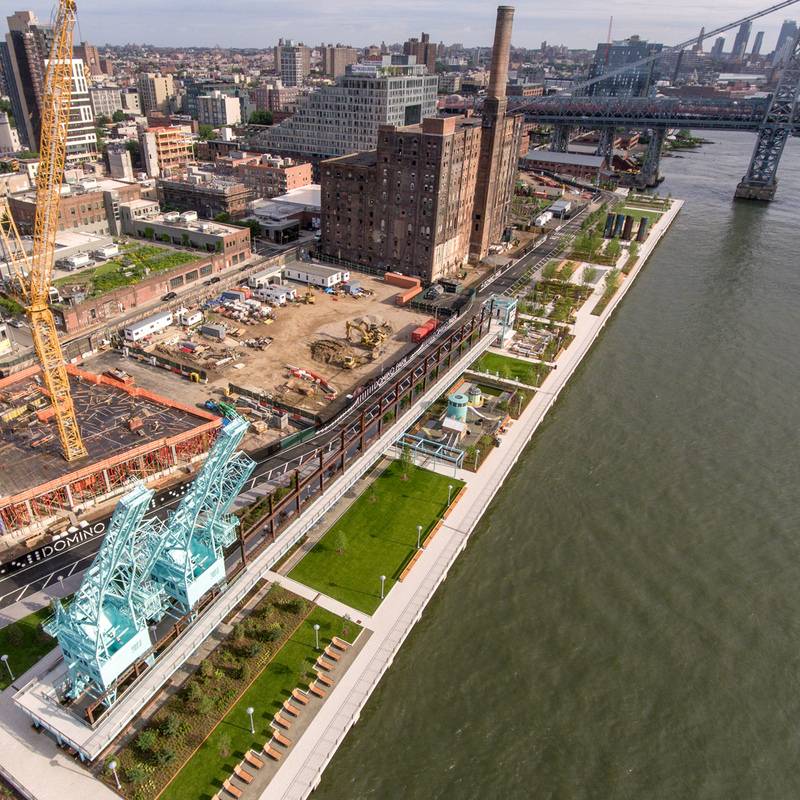 Photo by Daniel Levin, , courtesy Domino Park.
Photo by Daniel Levin, , courtesy Domino Park.
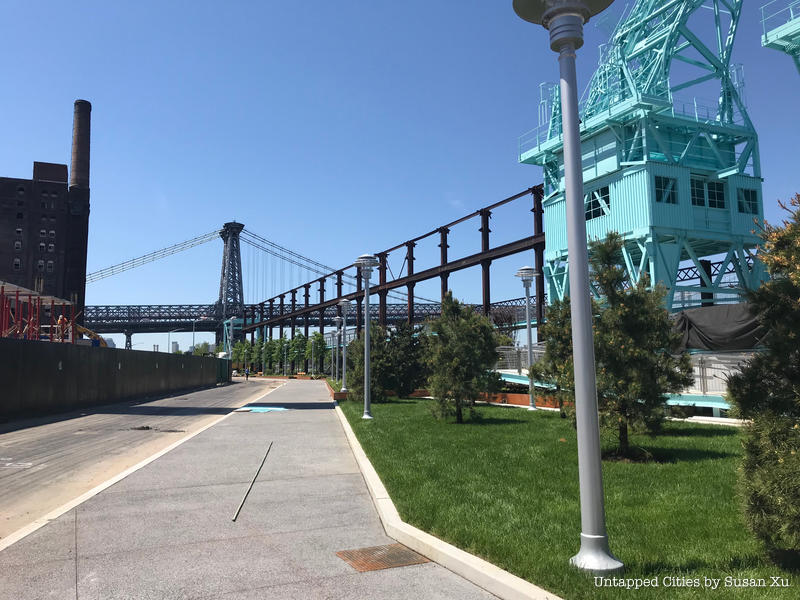
The historical significance of the surrounding Domino Sugar Refinery site and the importance of having the park serve as a public gathering area have served as obvious guiding principals for Two Trees’ overall vision for the project. As promised to the North Brooklyn community, Domino Park comes ahead of any of the forthcoming waterfront buildings and features a diverse range of recreational options for all ages, which we were given the opportunity to explore.
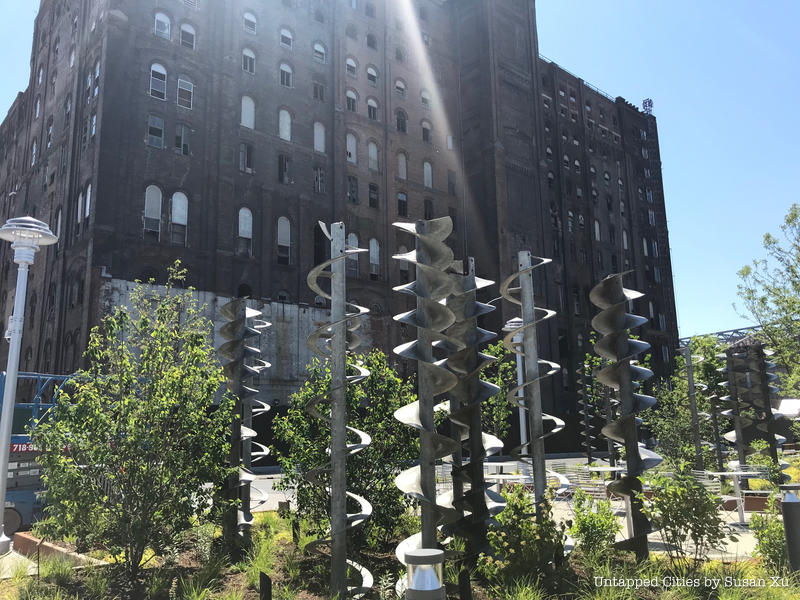 Screw converters framed by specially selected native plants. In total, the park will feature over 150 species of flora, which can tolerate high levels of saturation in the event of a flood. Species range from the June Berry and Honey Locus to the Willow Oak
Screw converters framed by specially selected native plants. In total, the park will feature over 150 species of flora, which can tolerate high levels of saturation in the event of a flood. Species range from the June Berry and Honey Locus to the Willow Oak
To start, we began our tour standing on the northernmost end of the five-block-long elevated Artifact Walk, where visitors can encounter 30-pieces of salvaged factory machinery and industrial artifacts from the Domino factory complex as they stroll across.
This includes soaring teal gantry cranes, 21 original columns from the sugar warehouse, a bucket conveyer, dials and meters with original signage, and rusting syrup tanks used during the sugar refining process. Taken in together with the incorporated Domino Sugar Refinery in the background as the crowning jewel, visitors are able to discover the history of sugar trade in New York City, and get a glimpse of the refining progress that occurred on the site for over a century.
Join us on opening day, where you can take a tour of the site for free, led by Untapped Cities in partnership with Two Trees from 12 – 4 PM. The tour will run every hour from 12:30 PM on. There are no advance reservations but you can join the tour if spots are available in person!
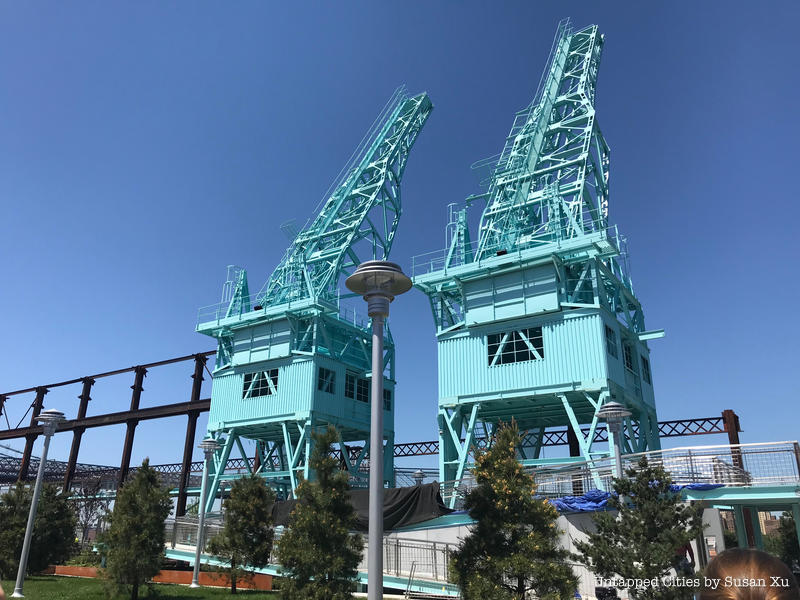 Teal gantries
Teal gantries
The elevated catwalk also provides an overhead view of the organization of the park itself, which is seamlessly divided into three programmatic areas. The northern end is reserved for more passive uses and gradually gives way to active uses as visitors draw closer to the southern side. The passive recreation area, from South 2nd Street to Grand Street, includes a Japanese Pine garden that leads to the Artifact Walk, a picnic area, an urban beach, places to sit in the sun, a taco kiosk, and a whimsical play ground, designed by artist Mark Reigelman (the mastermind behind the Smökers project), and inspired by the sugar refinery process.
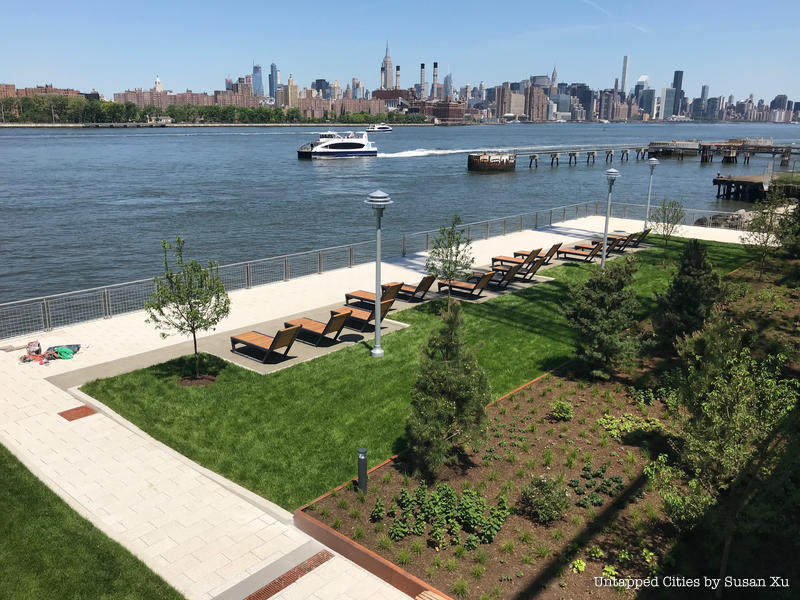
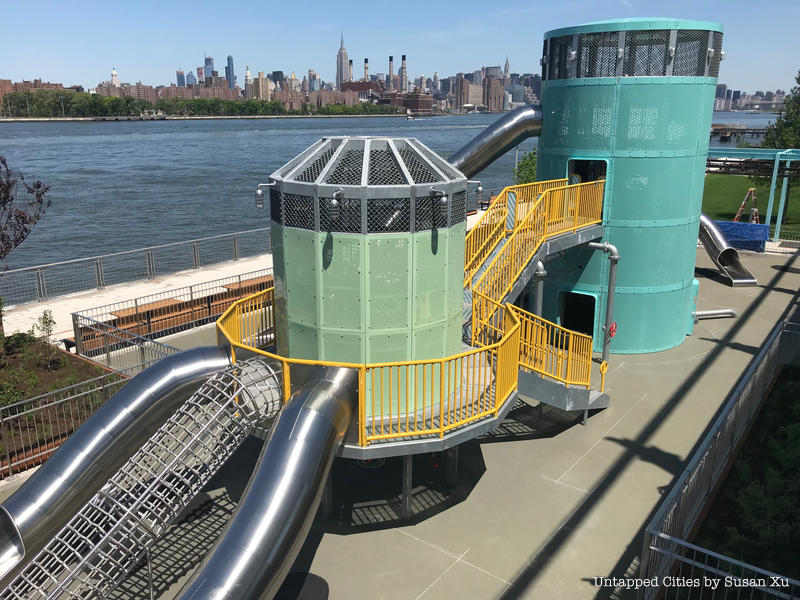 Brooklyn-based artist Mark Reigelman looked through historical photographs of the site to create his interpretation of a sugar refinery as imagined through the perspective of a child. Like the park itself, the playground also uses salvaged items
Brooklyn-based artist Mark Reigelman looked through historical photographs of the site to create his interpretation of a sugar refinery as imagined through the perspective of a child. Like the park itself, the playground also uses salvaged items
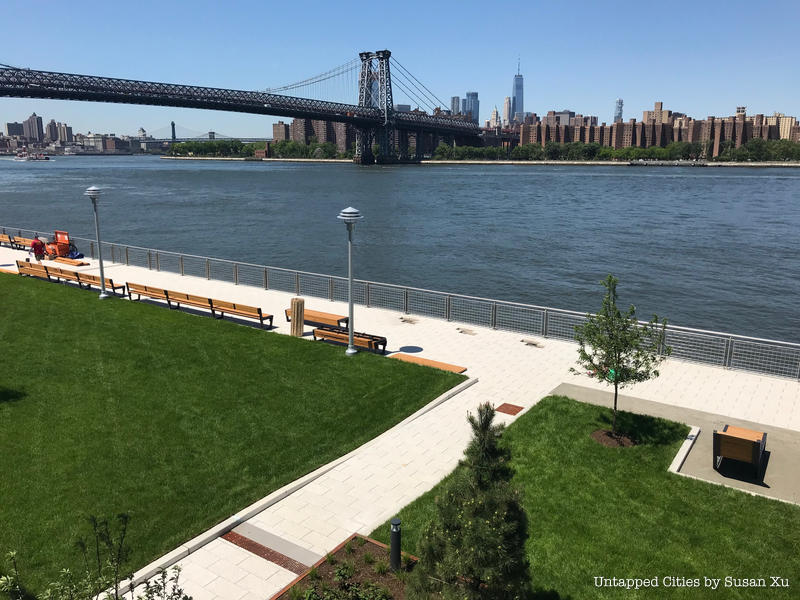
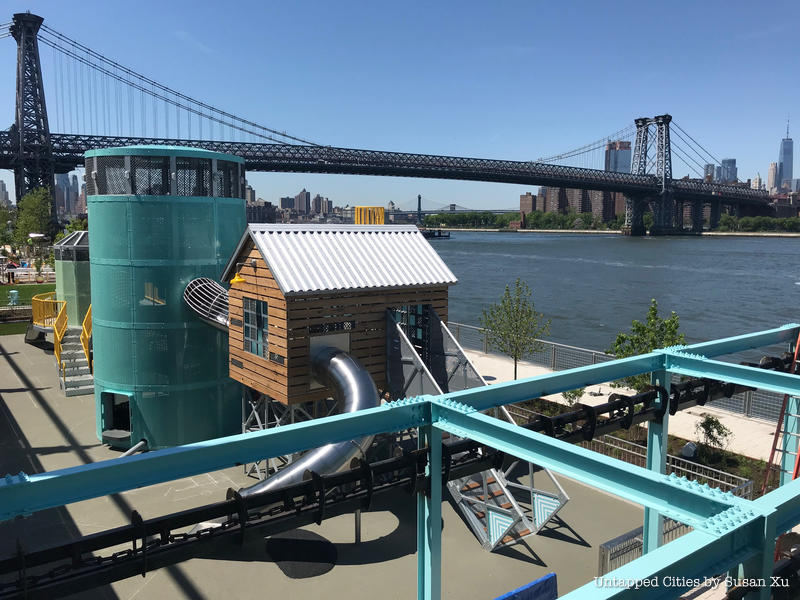 The red, yellow and blue hark back to the actual color palette of the refinery machines
The red, yellow and blue hark back to the actual color palette of the refinery machines
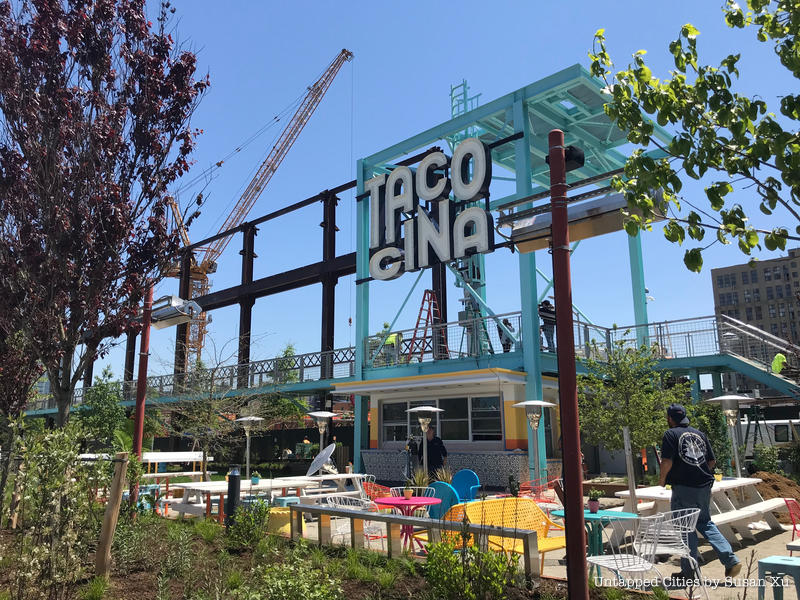 “Taco Cina” is the Union Square Hospitality Group’s first Brooklyn food and beverage operation, which will serve a menu of tacos, enchiladas, and drinks
“Taco Cina” is the Union Square Hospitality Group’s first Brooklyn food and beverage operation, which will serve a menu of tacos, enchiladas, and drinks
The center of the park will be utilized as the central gathering space, where guests can find a large seating area, made from salvaged wood and tiered on all sides to provide views of the East River as well as the Refinery building. It sits adjacent to the interactive Central Water Feature that can be specially programmed. For site developer, Two Trees, this feature was another way to allow the public to come closer to and interactive with the water.
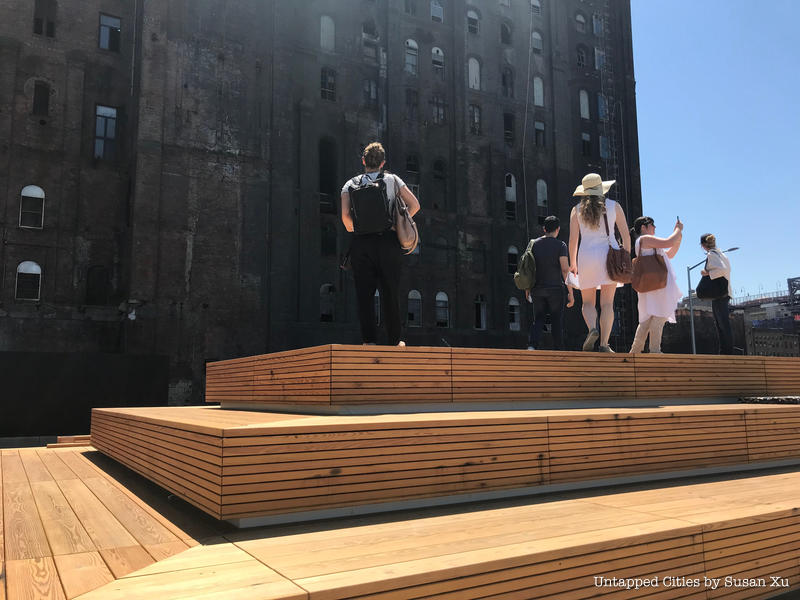 Four-tiered steps that acting as a seating option
Four-tiered steps that acting as a seating option
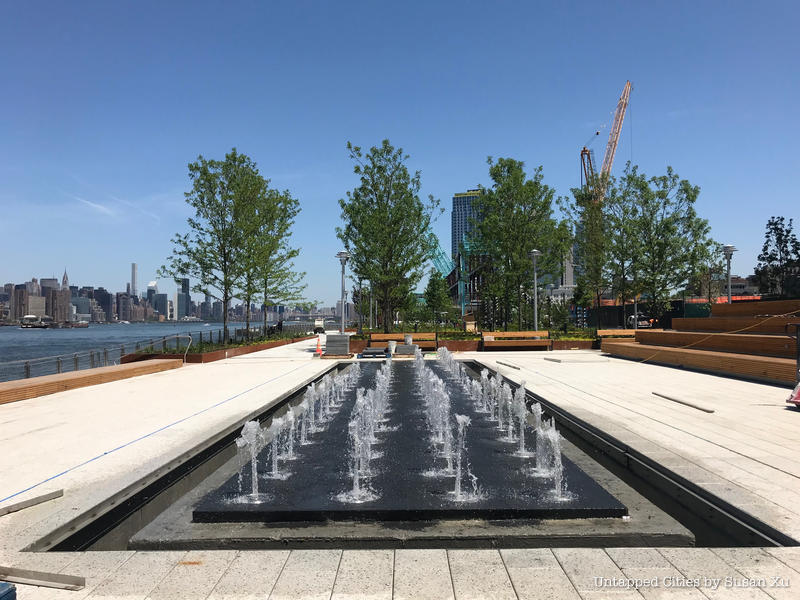 Water feature that will be programmable in the summer
Water feature that will be programmable in the summer
This wasn’t a simple task as the plan for Domino was submitted just three days after Hurricane Sandy hit, emphasizing the importance of a design that considered storm resiliency and protection. The whole park was consequently raised three to seven feet to be above the 100-year flood elevation level, and provides a 100-feet walkway up from the sea. The elevation means visitors will be at a further distance from the water, but there’s a cutout in the park ground, spanned by a bridge and framed by stainless steel railing, which shows original timber piers below and helps connect people to the water line regardless.
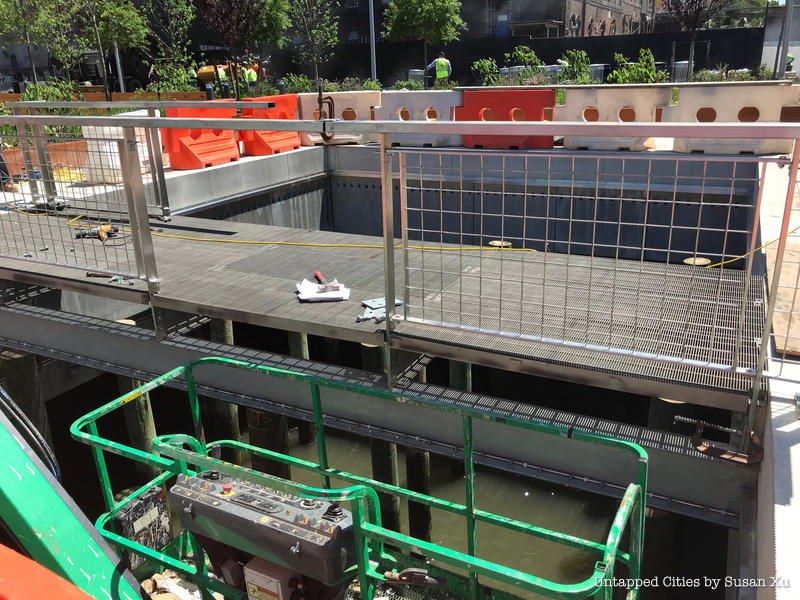 Original piers can be seen underneath the bridge
Original piers can be seen underneath the bridge
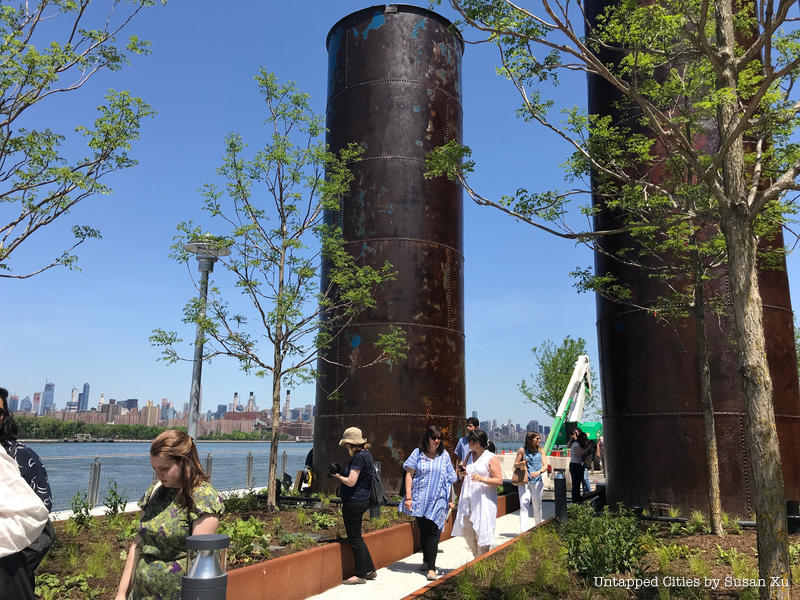 At the center of the park, there are also four salvaged syrup tanks, each 36-feet-tall
At the center of the park, there are also four salvaged syrup tanks, each 36-feet-tall
Towards the southern end of the park, active recreation features include interactive spaces, such as a 1,750-square-foot Dog Run, two Bocce courts, a 6,300-square-foot turf field and a sand volleyball court. Spanning the entire length of the park is the scenic 1,200-foot-long esplanade, which provides a smooth, continuous pathway through all sections of the park, not to mention panoramic views of the Williamsburg Bridge and the skyline.
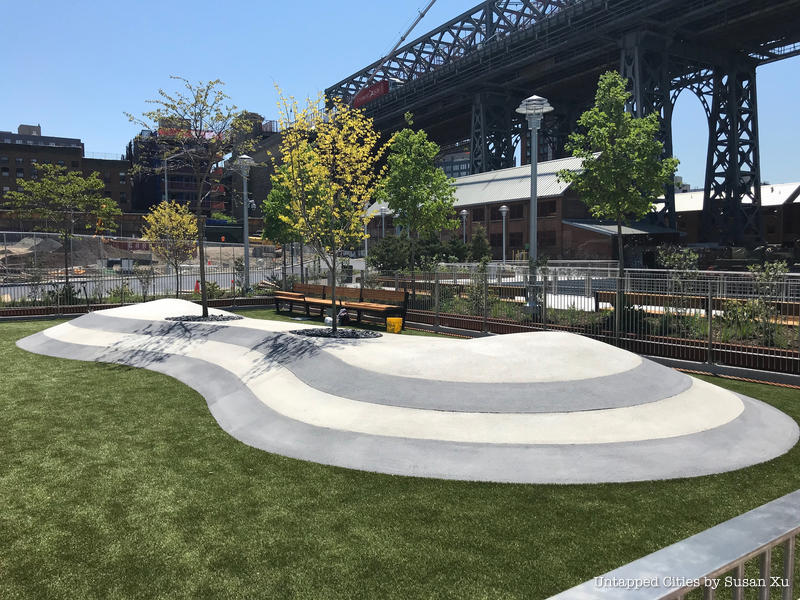 The Dog Run with non-toxic turf
The Dog Run with non-toxic turf
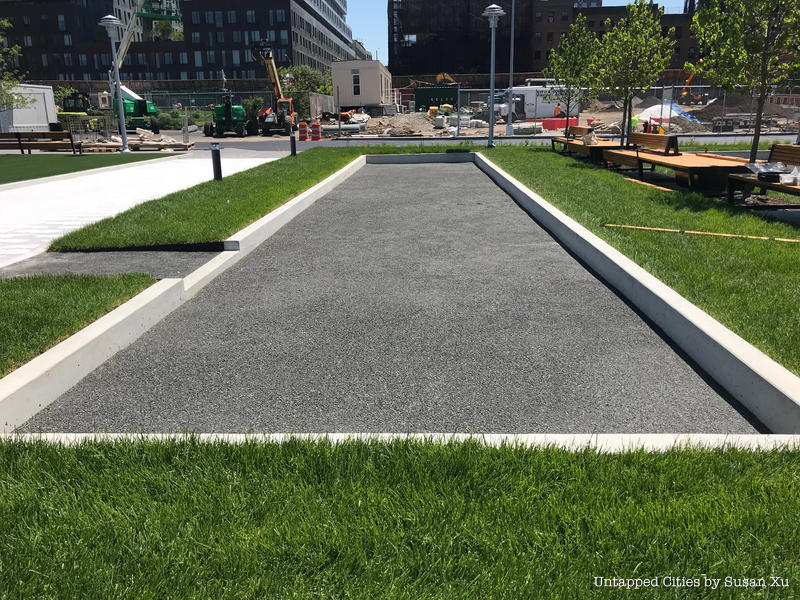 Bocce Ball courts
Bocce Ball courts
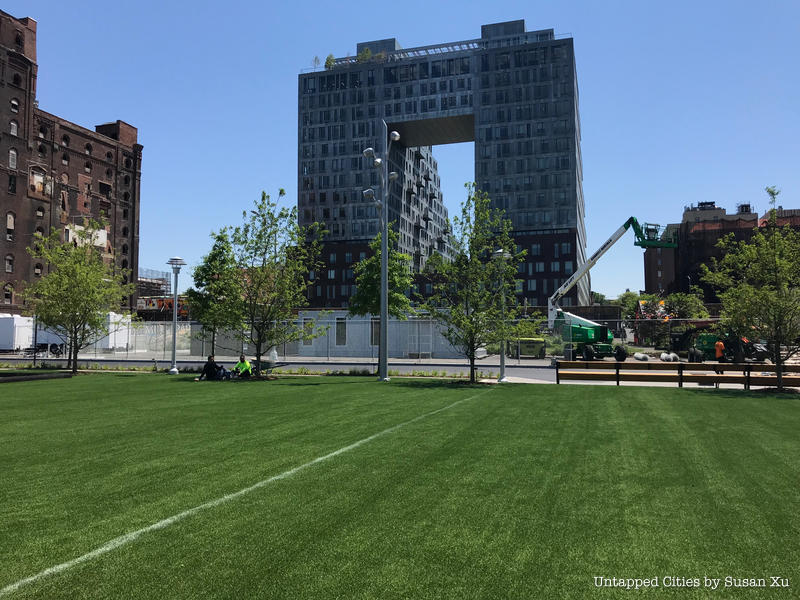 Flexible sports turf
Flexible sports turf
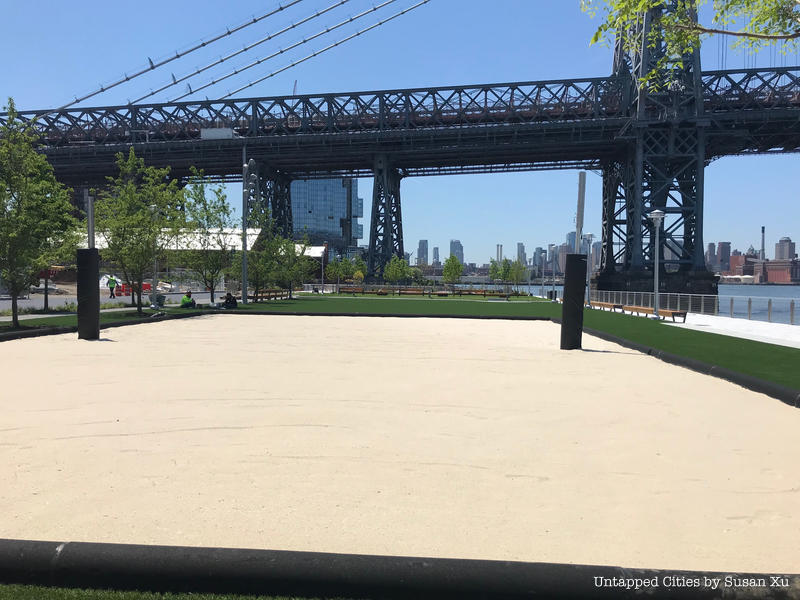 Volleyball court
Volleyball court
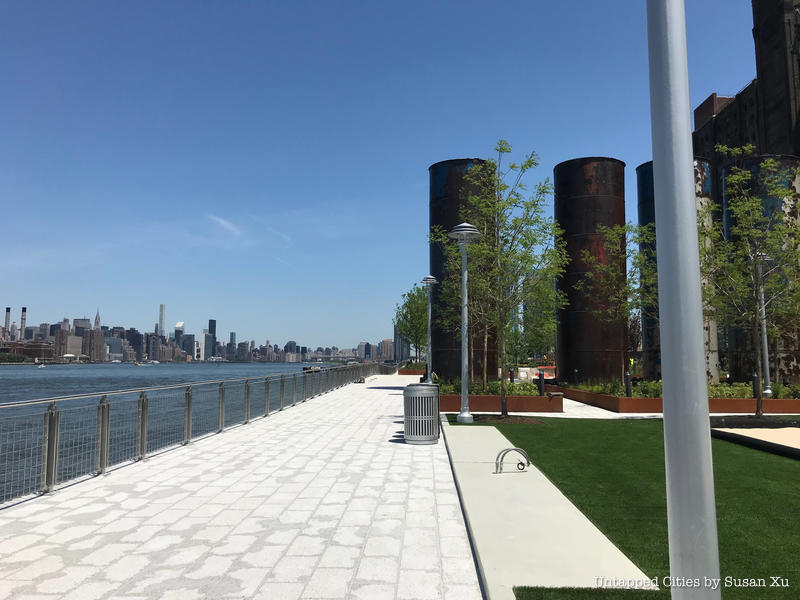 A view of the esplanade
A view of the esplanade
When Two Trees’ mega-development is completed, the Domino site will feature 200,000-square-feet of retail space, 600,000-square-feet of office space and 2,800 housing units (700 of which will be affordable). The central refinery building will also be converted into a 380,000-square-foot office campus. We’re told that a building is expected to come online every two years, with the final development site slated to kick off in five years or so. In the meantime, Domino Park will help to establish a sense of place for residents in the neighborhood, an area which has the worst ratio of population to open space in the city. Prior to Domino Park, Grand Ferry Park was really the only place where Williamsburg had access to the waterfront.
If you’re interested in learning more about Domino Park, join us on opening day, where you can take a tour of the site for free, led by Untapped Cities in partnership with Two Trees from 12 – 4 PM. The tour will run every hour from 12:30 PM on. There are no advance reservations but you can join the tour if spots are available in person!
Next, check out 39 NYC Outdoor Art Installations Not to Miss in June 2018 and discover the Top 10 Secrets of the Williamsburg Bridge.






